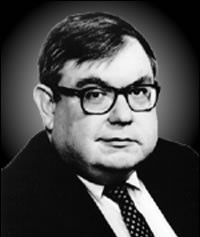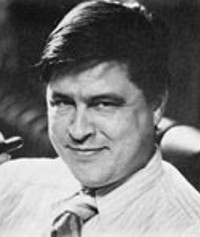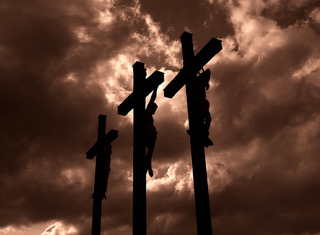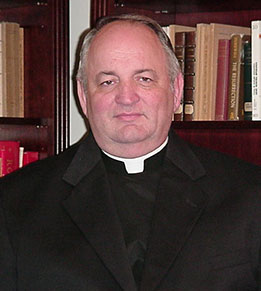 Samuel T. Francis
Samuel T. Francis
Championing
Western Civilization
and the great legacies of
Sam Francis and Joe Sobran
and their allies
 Joseph Sobran
Joseph Sobran
FGF Op-Ed
Littlemore Tracts
April 10, 2020

Behold the Man, Behold Man
by Rev. Mark A. Pilon
Fitzgerald Griffin Foundation
Ecce Homo – Behold the man
Littlemore Tracts, Good Friday 2013 -- One of the most horrific scenes in the movie, The Passion of the Christ, is certainly the scourging at the pillar, where Christ is so savagely beaten and tortured that it is difficult even to watch it on screen.
In fact, one of the early criticisms of the movie was that this was simply too savage, too overdone to be believable.
There is a value in this kind of graphic portrayal of the wounds of our Savior: these graphic presentations make us much more aware of the gravity of Christ’s sufferings and therefore the gravity of our sins for which He suffered.
That may be the case, but the movie certainly gives us a much better idea of the horrific suffering of our divine Savior than is normally portrayed in art where the wounds are normally greatly toned down for the sake of our human sensibilities.
But there is a value in this kind of graphic portrayal of the wounds of our Savior, and we see this at times in certain Spanish crucifixes which are known for the bloodiness of the corpus of Christ. The value is that these graphic presentations make us much more aware of the gravity of Christ’s sufferings and therefore the gravity of our sins for which He suffered.
Then there follows in the movie the scene where Christ is brought out by Pilate after the scourging and presented to the crowd, hoping that this scourging will satisfy their bloodlust and avoid his having to condemn Jesus to crucifixion.
The words, Ecce Homo, Behold Man, surely refer to Christ personally, but they refer to Christ in the context of his representing the whole of mankind, for He takes away the sins of the world, that is, the sins of man, every man, the whole of humanity.
Jesus is standing there wrapped in a robe, so most of His wounds are hidden, but simply the wounds on His sacred face, on His hands and feet are enough to make anyone shrink from the horror. Pilate simply says “Ecce homo” or “Behold the man.” His plan is not successful, but his words make it into the Gospels. “Behold the Man!” Pilate says, and it might well remind us of that point in the Mass where the priest says “Behold Him who takes away the sins of the world.”
We would do well on Good Friday to contemplate the deeper meaning of the words of Pilate. These words contain much deeper meaning than occurs to Pilate or the crowd. We might even translate the Latin words, Ecce Homo, as Behold Man. Surely they refer to Christ personally, but they refer to Christ in the context of His representing the whole of mankind, for He takes away the sins of the world, that is, the sins of man, every man, the whole of humanity.
Just as the human body of Jesus is lacerated and even deformed by the severity of His wounds, just so is the soul of man, wounded, lacerated, deformed by sin.
So, as He stands there before the crowd next to Pilate, and as His body is later fully uncovered at the crucifixion, we can use the images from the movie of the horrible wounds and gouges and scrapes to see something about Man that is most important.
These scourges of Jesus can be seen as the outward images of the interior condition of the human soul of every man as the result of his sins. Just as the human body of Jesus is lacerated and even deformed by the severity of His wounds, just so is the soul of man, wounded, lacerated, deformed by sin. The body of Jesus then speaks the truth about unredeemed man. This is the image of sin, the outward expression of the great deformity of the soul that Jesus has come to heal.
The scourged body of Jesus speaks the truth about unredeemed man. This is the image of sin, the outward expression of the great deformity of the soul that Jesus has come to heal.
The realism that we see in this kind of art which wants to portray the real truth about the terrible sufferings of the Lord and His passion, bespeaks the realism that we all need in evaluating what we are really like without the grace of Christ. Look at Jesus, O man, with all of His wounds, and you see your soul wounded by so many sins, lacerated by evil.
But at the same time, these wounds of Christ speak of love, the infinite love that went to such lengths not only to free us from sin, but to make us hate it the way it deserves to be hated.
Venial sin wounds the soul, perhaps even lacerates the soul, like the scourges of the Roman soldiers, while mortal sin includes and goes beyond these wounds and literally kills the divine life in the soul.
And His wounds also speak of the great dignity of man, for Jesus did all this as a man, and He did it to recover man’s dignity for us. How great man must be, then, in the vision of God, man’s creator and more wonderfully yet, his redeemer.
Our world tends to trivialize evil in all its forms. Even good Catholics will trivialize evil by saying in confession. “I told a little white lie,” as if the evil involved in that small lie is not something for which Christ suffered and died.
Even venial sin wounds the soul, perhaps even lacerates the soul, like the scourges of the Roman soldiers, while mortal sin includes and goes beyond these wounds and literally kills the divine life in the soul.
Look at Jesus, O man, with all of his wounds, and you see your soul wounded by so many sins, lacerated by evil.
Why do we think St. Paul said that he was the worst of sinners, even though we can hardly imagine him committing a serious sin, at least after his conversion? And the same is true of so many saints whom we can hardly imagine ever committing a serious sin in their lives, and yet they speak of their venial sins with a horror that we scarcely have for our serious sins.
The Lord’s passion teaches us about sin and its consequences in a way that nothing else could possibly do, enlightens our darkened souls as nothing else can.
The Lord’s passion teaches us about sin and its consequences in a way that nothing else could possibly do, enlightens our darkened souls as nothing else can.
But that passion also teaches us about love, the “no greater love” that Jesus speaks about in the Gospels, the kind of love that goes to the limits of human endurance and conquers.
It is that love which Jesus pours into our hearts and makes it possible for us to escape the despair which we might feel on Good Friday realizing what our sins have done to Him in His passion. That is why the great teachers, like Aquinas, insist that the greatest path to Christian perfection passes through our meditation on the passion of Christ. They are right and we do well to take their advice.
###
Copyright @ 2025 by Rev. Mark A. Pilon and the Fitzgerald Griffin Foundation. “Behold the Man, Behold Man” was a homily given by Fr. Pilon on Good Friday, March 29, 2013. This article may be reprinted if credit is given to Fr. Pilon and fgfBooks.com. If reposting, please use a live link to this page.
Rev. Mark A. Pilon (1943-2018) was a priest of the Diocese of Arlington. He had several advanced degrees, including an STL, summa cum laude, from the John Paul II Institute at the Lateran University; an STD, magna cum laude, from the Pontifical University of the Holy Cross in Rome; and an M.S. in education from Catholic University of America. At various times, he taught at Mount St. Mary’s Seminary, Christendom College, Catholic University of America, and at the Christian Commonwealth Institute in Spain.
Read more of his homilies at Littlemore Tracts.
Help the Fitzgerald Griffin Foundation in its mission to publish the writings of Fr. Mark A. Pilon and other great writers. Give a tax-deductible donation to FGF online
Or send a check to: Fitzgerald Griffin Foundation344 Maple Avenue West, #281
Vienna, VA 22180
1-877-726-0058
publishing@fgfbooks.com
Or call toll-free at 1-877-726-0058 to donate by phone. For more information, write to Fran Griffin at fgf@fgfBooks.com
